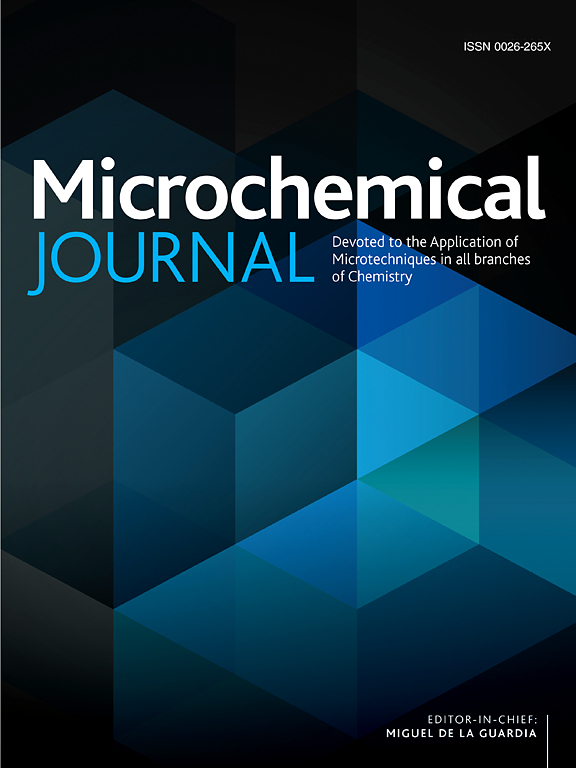Evaluation of the interaction mechanism of dsDNA-propofol binding: Electrochemical, thermodynamic, molecular docking studies and comet assay
IF 4.9
2区 化学
Q1 CHEMISTRY, ANALYTICAL
引用次数: 0
Abstract
Propofol, a widely used intravenous hypnotic agent, is favored in medical settings due to its rapid onset and short duration of action. This study systematically assessed the interaction between propofol and DNA using voltammetry, fluorescence spectroscopy, molecular docking, and comet assay analysis. The voltammetric peak responses for dGuo and dAdo on the ct-dsDNA biosensor were detected at 0.96 V and 1.23 V, respectively. 4 × 10−7 mol L−1 propofol at 300 s were selected as optimal interaction concentration, which significantly reduced the peak currents of dsDNA signals. In the incubation solution, a significant decrease in the peak currents of both dGuo and dAdo was observed in the 1 × 10−4 mol/L propofol. To analyze the quenching mechanism, experiments were conducted at various temperatures with Stern-Volmer plots using the fluorescence titration method. The decrease in Ksv values as temperature increases suggests an involvement of static quenching. ΔH° < 0 and ΔS° < 0 indicate the hydrogen bonds and van der Waals interactions; ΔG° < 0 and Kb value of 1.26 × 106 L.mol−1 demonstrate spontaneous interactions between propofol and DNA. Iodide quenching studies revealed that propofol may interact with dsDNA by groove binding. In the comet assay, the highest level of DNA damage was observed at 200 μg/ml propofol concentration. In silico studies, it has been supported that propofol binds to specific minor regions on DNA, forming van der Waals interactions.

ddna -异丙酚结合相互作用机理的评价:电化学、热力学、分子对接研究和彗星分析
丙泊酚是一种广泛使用的静脉催眠药,因其起效快、作用时间短而在医疗领域备受青睐。本研究采用伏安法、荧光光谱法、分子对接法和彗星试验分析法系统地评估了丙泊酚与 DNA 之间的相互作用。dGuo 和 dAdo 在 ct-dsDNA 生物传感器上的伏安峰响应分别为 0.96 V 和 1.23 V。选择 4 × 10-7 mol L-1 丙泊酚在 300 秒内作为最佳相互作用浓度,可显著降低 dsDNA 信号的峰值电流。在孵育液中,观察到 1 × 10-4 mol/L 异丙酚可显著降低 dGuo 和 dAdo 的峰值电流。为了分析淬灭机制,在不同温度下使用荧光滴定法绘制了 Stern-Volmer 图。Ksv 值随着温度的升高而降低,这表明其中有静态淬火的参与。ΔH° < 0 和 ΔS° < 0 表示氢键和范德华相互作用;ΔG° < 0 和 Kb 值 1.26 × 106 L.mol-1 表明异丙酚和 DNA 之间存在自发相互作用。碘化物淬灭研究表明,异丙酚可能通过沟结合与 dsDNA 发生相互作用。在彗星试验中,浓度为 200 μg/ml 的异丙酚对 DNA 的损伤程度最高。硅学研究证实,异丙酚与 DNA 上的特定次要区域结合,形成范德华相互作用。
本文章由计算机程序翻译,如有差异,请以英文原文为准。
求助全文
约1分钟内获得全文
求助全文
来源期刊

Microchemical Journal
化学-分析化学
CiteScore
8.70
自引率
8.30%
发文量
1131
审稿时长
1.9 months
期刊介绍:
The Microchemical Journal is a peer reviewed journal devoted to all aspects and phases of analytical chemistry and chemical analysis. The Microchemical Journal publishes articles which are at the forefront of modern analytical chemistry and cover innovations in the techniques to the finest possible limits. This includes fundamental aspects, instrumentation, new developments, innovative and novel methods and applications including environmental and clinical field.
Traditional classical analytical methods such as spectrophotometry and titrimetry as well as established instrumentation methods such as flame and graphite furnace atomic absorption spectrometry, gas chromatography, and modified glassy or carbon electrode electrochemical methods will be considered, provided they show significant improvements and novelty compared to the established methods.
 求助内容:
求助内容: 应助结果提醒方式:
应助结果提醒方式:


